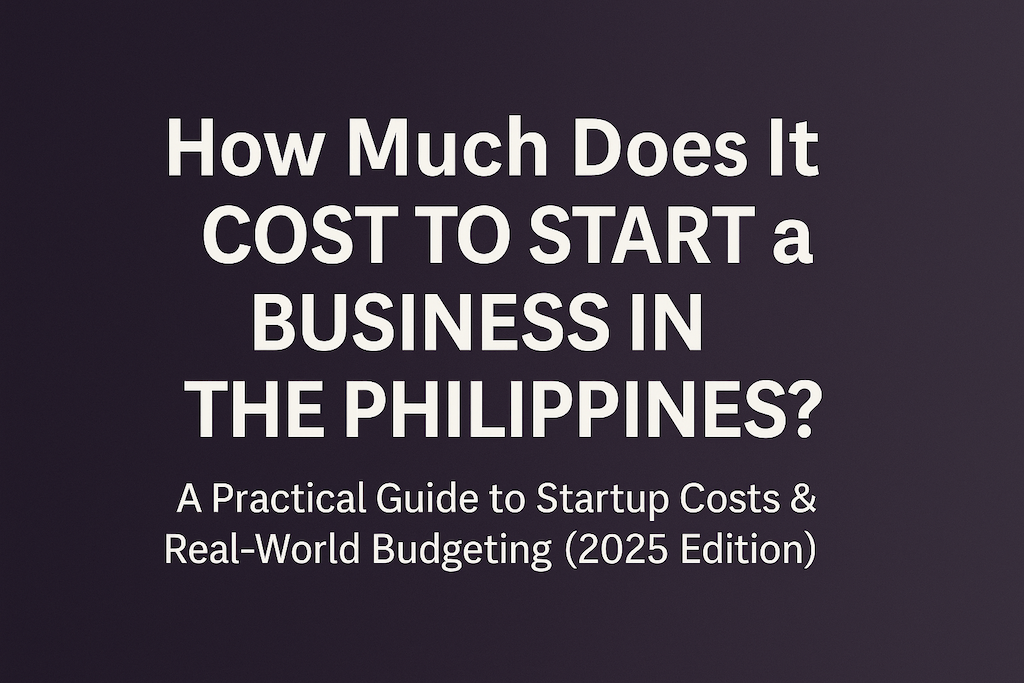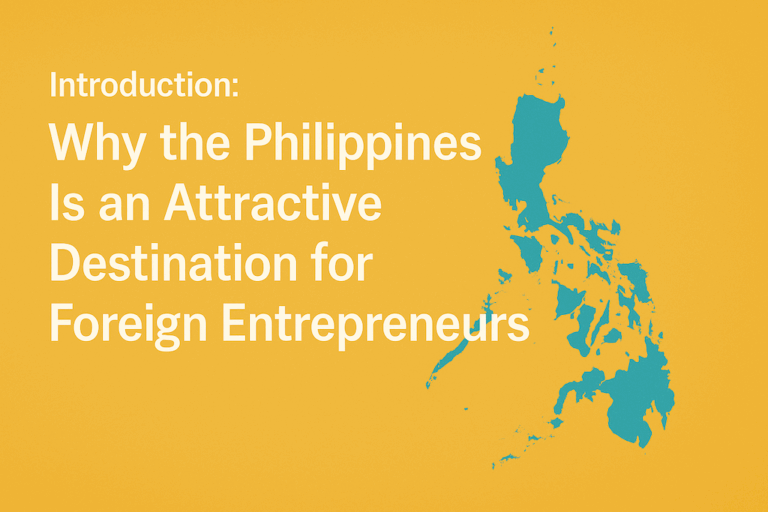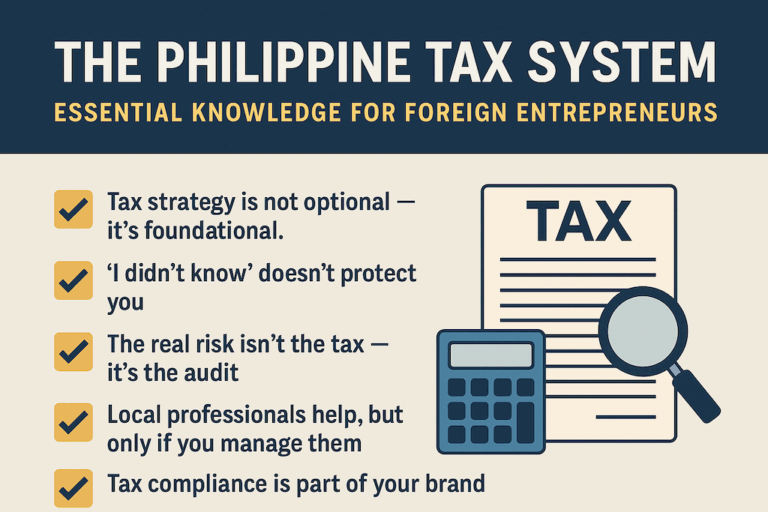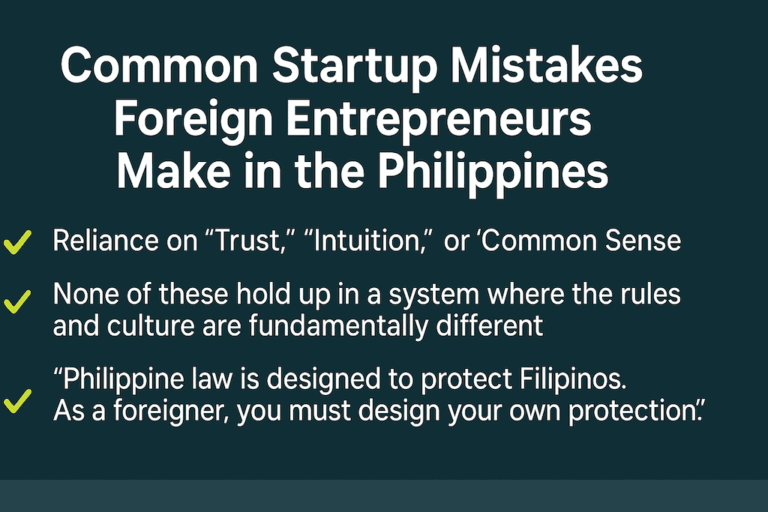How Much Does It Cost to Start a Business in the Philippines? A Practical Guide to Startup Costs & Real-World Budgeting (2025 Edition)
🇵🇭 How Much Does It Cost to Start a Business in the Philippines?
A Practical Guide to Startup Costs & Real-World Budgeting (2025 Edition)
✅ Introduction: Why Understanding Startup Costs Matters
The Philippines is often seen as a low-cost destination for launching a business, especially compared to countries like Japan or the U.S. Company registration is relatively straightforward, and minimum capital requirements aren’t overly restrictive.
However, many foreign entrepreneurs face an early exit due to underestimating startup costs — not because they couldn’t register a company, but because they couldn’t sustain it.
Here’s why understanding the full picture of expenses is crucial:
① Incorporation fees are just the tip of the iceberg
Registering a company might only cost around $150–$400, but that’s just the beginning. Once you factor in business permits, BIR registration, official receipt printing, and accounting setup, costs and paperwork start piling up.
✅ “I registered the company but couldn’t legally operate” — a common early-stage pitfall.
② “Low entry cost” ≠ “low running cost”
Sure, wages may seem cheap (e.g., $250/month for entry-level staff), but what about social security, absences, or turnover costs? In many cases, you’ll face tax, rent, and compliance payments before you earn your first peso.
✅ Without understanding the cash flow cycle, your runway will dry up early.
③ Exchange rates and import volatility
If your business depends on imported goods (like Japanese ingredients or equipment), expect major cost swings. In 2024–2025, the yen weakened dramatically — raising import costs by 1.5× to 2× for many SMEs.
✅ In a volatile import economy, a flexible procurement plan is essential.
④ Soaring utility & import-linked costs
The Philippines is sometimes cited as the 2nd most expensive country in the world for electricity, especially in businesses reliant on air conditioning or refrigeration.
Other utilities (water, gas, telecom) can match or exceed developed-country prices, depending on the area.
✅ Budgeting for utilities and equipment replacement is a must — not an afterthought.
⑤ Know the “upfront payment culture” for contracts
It’s common for lease agreements and major purchases to require advance payment. In recent years, this has softened somewhat due to inflation and competition, but for mid-to-large commercial properties:
| Item | Typical Initial Payment Terms (as of 2025) |
|---|---|
| Office/store lease | 1–2 months advance rent + 2–6 months security deposit |
| Interior construction | 30–50% upfront or full payment upon completion |
| Equipment/furniture | Full payment (cash or bank transfer) |
| Utility/Internet connection | 1 month deposit + installation/setup fees |
✅ Tip: Lease-related cash outflow is often underestimated. Always review payment terms in advance and negotiate where possible.
⑥ “Initial setup” isn’t the end — you need buffer capital
Unexpected costs often arise post-launch:
-
Re-inspections by fire or sanitation departments
-
POS or internet system failures (requiring replacements)
-
Extra hiring costs due to staff turnover
-
Sales ramp-up delays
✅ Don’t ask: “What’s the minimum I need to launch?”
Ask: “Can I survive the next 6 months if things go wrong?”
🔍 Summary: It’s not about “how cheap you start” — it’s about “how long you can endure”
Yes, launching a business in the Philippines can be faster and more accessible than in many other countries.
But it’s also common to see businesses fold within a year because they underestimated the hidden costs and lacked financial resilience.
In this article, we’ll break down not only incorporation fees but also:
-
Realistic operating costs
-
Local payment structures
-
Budgeting strategies for year one
In the next section, we’ll begin with a detailed breakdown of business registration and the exact costs you should prepare for.
✅ Step 1: Basic Costs of Incorporating a Business in the Philippines
From SEC to BIR — What You Really Need to Start Operating Legally
Setting up a corporation in the Philippines involves multiple steps across several government agencies. Each step comes with its own fees. In practice, foreign entrepreneurs should expect to spend between $600 to $1,800 USD during the incorporation phase.
Here’s a breakdown of the key costs:
◉ 1. SEC Registration (Securities and Exchange Commission)
Estimated cost: $140–$200 USD
Includes registration fees, document review, and name reservation.
🔹 Cost varies depending on your declared capital (e.g., for ₱100,000 capital, registration is approximately ₱8,000).
🔹 Required documents include:
• Articles of Incorporation
• By-laws
• Treasurer’s Affidavit
• Name Reservation (₱115 for 30 days)
◉ 2. Barangay Clearance (Neighborhood Permit)
Estimated cost: $10–$30 USD
🔹 Obtained from the local barangay office where your office is located.
🔹 Required documents:
• SEC Certificate
• Lease Contract
• Valid ID and completed application form
◉ 3. Mayor’s Permit (Business License)
Estimated cost: $90–$350 USD
🔹 Issued by City Hall. The fee depends on your office size, projected revenue, and type of business.
🔹 Pre-requisites:
• Sanitary Permit
• Fire Safety Inspection Certificate
• Zoning Clearance
◉ 4. BIR Registration (Bureau of Internal Revenue)
Estimated cost: $200–$300 USD
🔹 Includes:
• Annual Registration Fee (₱500 ≈ $9 USD)
• Authority to Print (ATP) + Official Receipt printing (~₱10,000–₱15,000)
• Books of Accounts (manual or computerized)
🔹 BIR Form 2303 (Certificate of Registration) is required to open a bank account and legally issue receipts.
⚠️ Operating without ORs (Official Receipts) is subject to fines and penalties.
◉ 5. Professional & Service Fees (Accountants, Lawyers, Brokers)
Estimated cost: $180–$900 USD
🔹 Varies based on the scope of services.
🔹 May include:
• Document preparation and submission
• Notarization fees
• Legal retainer or startup consultation
✅ Estimated Total Startup Cost for Incorporation
| Item | Cost (PHP) | Cost (USD) | Notes |
|---|---|---|---|
| SEC Registration | ₱8,000–₱12,000 | $140–$200 | Varies by capital |
| Barangay Clearance | ₱500–₱1,500 | $10–$30 | Neighborhood-dependent |
| Mayor’s Permit | ₱5,000–₱20,000 | $90–$350 | Based on size/revenue |
| BIR Registration + OR | ₱10,500–₱15,500 | $180–$300 | OR + bookkeeping |
| Legal/Accounting Services | ₱10,000–₱50,000 | $180–$900 | Optional but strongly recommended |
| Total Estimated Cost | ₱34,000–₱99,000 | $600–$1,800 USD | Approximate range |
✅ Key Insight:
While incorporation itself might seem affordable, the full setup to become fully compliant and operational takes more than just registering a name. You’ll need receipts, accounting books, permits, and support from trusted professionals.
✅ Step 2: Initial Costs for Renting and Setting Up an Office or Storefront
Security deposits, renovations, and the hidden risks of leasing in the Philippines
Once your company is incorporated, the next critical step is securing a physical location for operations — whether it’s an office, retail store, or classroom. Leasing space and building it out requires a significant upfront investment.
You should realistically prepare to spend between $4,000 to $27,000 USD, depending on the size and nature of the business.
◉ 1. Advance Rent + Security Deposit
In the Philippines, most landlords require both an advance rental payment and a security deposit upon signing the lease.
Typical requirement:
-
Security Deposit: 2–6 months’ rent
-
Advance Rent: 1–2 months
-
Total upfront payment = 3 to 4 months’ rent
✅ Example:
Monthly rent: ₱30,000 ($530 USD)$1,600–$3,600 USD)
Required upfront payment: ₱90,000–₱200,000 (
Important Notes:
-
Security deposits are refundable upon move-out but are often reduced due to repair charges or unpaid utilities.
-
Rent is sometimes negotiable, especially for long-term contracts.
◉ 2. Fit-Out and Renovation Costs
This is often the most unpredictable and budget-draining part of setting up your business.
Cost Range:
-
Small-scale renovation: ₱50,000–₱200,000 (~$900–$3,600 USD)
-
Medium to large-scale: ₱1,000,000+ (~$18,000 USD or more)
Typical work includes:
-
Partitions, flooring, ceiling installation
-
Electrical and lighting systems
-
Plumbing for kitchens/restrooms
-
Furniture and equipment installation
⚠️ The 3 Harsh Realities of Dealing with Local Contractors:
-
Delays are common.
A job quoted as “3 weeks” may take 3 to 6 months. Holidays, rain, labor shortages, and vague commitments lead to frequent pauses. -
Cost overruns are typical.
Hidden costs and vague estimates often emerge after the project has started. Miscommunication is common. -
Quality varies widely.
Poor workmanship, missed deadlines, or disappearing contractors (especially independent tradesmen) are common.
✅ Tips for Minimizing Risk:
-
Require a clear, written Scope of Work with itemized cost estimates
-
Structure payments in stages (e.g., 30% upfront, 40% midpoint, 30% upon completion)
-
Have a Filipino partner or lawyer review and attend signings
-
Use referrals, verified Facebook groups, or other expat networks to find trusted contractors
◉ 3. Furniture, Equipment, and Connectivity Setup
-
Office furniture (tables, shelves, chairs): ₱20,000–₱100,000 (~$350–$1,800 USD)
-
Internet and phone line setup: ₱3,000–₱15,000 (~$50–$270 USD)
-
Generator (if needed): ₱20,000–₱100,000 (~$350–$1,800 USD)
✅ Estimated Initial Setup Costs for Lease and Renovation
| Category | Cost (PHP) | USD Equivalent | Notes |
|---|---|---|---|
| Rent (3–4 months advance) | ₱90,000–₱200,000 | ~$1,600–$3,600 | Based on ₱30,000/month estimate |
| Renovation & Equipment | ₱50,000–₱1,000,000+ | ~$900–$18,000+ | Depends on size and business type |
| Furniture / Connectivity | ₱30,000–₱200,000 | ~$500–$3,600 | Includes Wi-Fi, power, etc. |
| Total Estimate | ₱220,000–₱1,500,000 | $4,000–$27,000 USD | Wide range based on scope |
✅ Summary: Always Plan for Double the Time and Budget
-
Renovation contractors often delay, so assume at least 3–6 months lead time
-
Verify whether your lease allows renovations or signage before signing
-
Build in contingency funds and stage payments for risk control
✅ Step 3: Visa & Immigration Costs for Foreign Business Owners
Why choosing the right visa should be part of your startup planning
When starting a business in the Philippines, registering a corporation is only part of the equation. As a foreign entrepreneur, you must also ensure your personal immigration status is legal and aligned with your business activities.
While it’s possible to “test the waters” under a tourist visa, any mid- to long-term operation will require a valid visa. Below are the most relevant visa options for business owners, along with estimated costs.
◉ 1. 9G Visa (Employment Visa)
✅ Most Common for Business Owners
This is the most widely used visa by foreign company directors or managers who are employed by their own corporation.
-
Eligibility: Officers or employees of a registered Philippine corporation
-
Validity: 1-year renewable
-
Application Process: Multi-agency approvals including DOLE, BOI/BID, BIR, etc.
Estimated Initial Cost (with agency support):
$1,000–$2,100 USD
Processing Time: 2–3 months
📌 Note: Your corporation must be fully compliant and registered before applying.
◉ 2. 13A Visa (Spouse Visa)
✅ Ideal for those married to a Filipino citizen
One of the most stable and long-term visa options. Issued to foreigners legally married to a Filipino.
-
Requirements: Marriage certificate, proof of cohabitation
-
Process: 1-year probationary visa → permanent residency
Estimated Initial Cost:
Visa Fees: $270–$450 USD
Total (including translation, notarization): $700–$1,100 USD
📌 Note: While it offers strong residency rights, this visa does not automatically allow business activities — separate compliance may be required for corporate involvement.
◉ 3. SRRV (Special Resident Retiree’s Visa)
✅ Permanent Residency Option for 50+
Popular among retirees, this investment-based visa can also be adapted for business purposes.
-
Eligibility: Age 50+
-
Deposit Requirement: $20,000–$50,000 USD (varies by plan)
-
Benefits: No renewal needed, multiple re-entry, residency status
Estimated Initial Cost:
Required Deposit: $20,000+ USD
Processing Fee: ~$2,000 USD (excluding agency fees)
📌 Technically not a business visa, but many SRRV holders serve as corporate investors or board members.
◉ 4. Tourist Visa Extensions
✅ Short-Term Option / Not for Business Use
Start with a 30-day stay (varies by nationality), renewable in 2-month increments up to 3 years.
Cost Estimate for 6-Month Stay:
First Extension: $70–$90 USD
Subsequent renewals: ~$50–$70 per extension
Total: ~$250–$350 USD
📌 Warning: Tourist visas prohibit work. Not ideal for banking, licensing, or legal filings.
✅ Visa Comparison Table (Costs & Compatibility)
| Visa Type | Validity | Est. Initial Cost | Business Suitability |
|---|---|---|---|
| 9G (Employment) | 1-year renewable | $1,000–$2,100 USD | ✅ Best option for startup owners |
| 13A (Spouse) | Permanent | $700–$1,100 USD | ✅ Strong if married to a Filipino |
| SRRV | Permanent | $20,000+ USD | ⚠️ Only for age 50+; not ideal for all |
| Tourist Visa | Up to 3 years | $250–$350 USD | ❌ Not permitted for business use |
✅ Summary: Registering a Business ≠ Legally Staying in the Country
When launching your startup, make sure you plan both your company structure and your personal visa pathway. Your legal status affects:
-
Tax filings
-
Bank account creation
-
Licensing and government communication
📌 Pro Tip: Reverse-plan your visa based on your 3–6 month business roadmap — it can save you from costly delays later.
✅ Step 4: Hiring Staff & Initial Labor Costs
“Yes, labor is cheap — but stability comes at a hidden price.”
The Philippines is often regarded as a low-cost labor market, where you can hire workers for as little as 1/5 to 1/10 of what you’d pay in Japan or Western countries. It’s true that the minimum daily wage ranges from ₱500–₱600 ($9–$11 USD/day).
However, successfully building a reliable team requires more than just offering a monthly salary. You must also factor in initial hiring costs, compliance expenses, training, and turnover risk — especially if you want your staff to stay.
◉ 1. Initial Hiring Costs (Per Employee)
| Item | Cost Estimate (USD) | Notes |
|---|---|---|
| Job ads/postings | $0–$55 | Facebook, JobStreet, or even printed flyers |
| Training and onboarding | $20–$55 | OJT, manuals, uniforms |
| Medical certificate | $5–$10 | Required for some sectors like F&B |
| Contracts & company policies | Varies (DIY or legal fee) | Prevents future disputes |
✅ Takeaway: Even if you’re hiring “cheaply,” expect to spend $50–$100 USD per new hire before they become productive.
◉ 2. Average Starting Salaries in Cebu/Manila (2025 Estimates)
| Role | Monthly Salary (PHP) | Monthly Salary (USD) | Notes |
|---|---|---|---|
| Entry-level (F&B, retail) | ₱13,000–₱16,000 | ~$230–$280 USD | Based on 22 working days |
| Junior Manager | ₱18,000–₱30,000 | ~$320–$530 USD | Varies by experience, English skills |
| Admin / Accounting | ₱15,000–₱25,000 | ~$270–$440 USD | Accounting background preferred |
| ESL English Teacher | ₱16,000–₱28,000 | ~$280–$500 USD | Depends on TOEIC/teaching experience |
◉ 3. Mandatory Employer Contributions
Once you hire staff, the company must contribute to the following government programs monthly:
| Program | Description | Employer’s Share |
|---|---|---|
| SSS | Social Security (retirement) | ~8% of salary |
| PhilHealth | Public healthcare insurance | ~2.75% of salary |
| Pag-IBIG | Housing Fund | ₱100/month flat (~$2) |
| Withholding Tax | Income tax based on bracket | Employer must deduct & remit |
✅ Example: Hiring someone at ₱15,000/month (~$265) means you’ll pay an extra ₱1,500–₱2,000 ($26–$35 USD) in government-mandated benefits.
◉ 4. Hidden Risks of Hiring in the Philippines
| Risk Type | Common Scenarios |
|---|---|
| High turnover rate | Many employees quit within 1 month |
| Chronic absenteeism or tardiness | Regular late arrivals or no-shows |
| Manager collusion | Managers may protect underperforming staff |
| Unpredictable replacement cost | Re-hiring and re-training can be frequent |
🧠 Key Insight: Don’t treat labor as a “fixed cost.” In the Philippines, staffing is a fluctuating investment.
✅ Summary: Hiring is cheap — but retention is expensive
| Cost Type | Estimated Range |
|---|---|
| Initial hiring cost | $50–$100 per employee |
| Monthly salary | $150–$500 depending on role |
| Government benefits | Add 10–15% on top of salary |
| Turnover rate | High in most entry roles |
▶ Conclusion:
Don’t just ask “How cheap can I hire?” — Ask “How can I build a team that stays?”
Design your labor systems — contracts, evaluations, work schedules — from the start. The more structure you have upfront, the less cost and chaos you’ll face later.
✅ Step 5: Hidden Startup Costs You Must Not Overlook
~ In the Philippines, “unexpected expenses” are part of doing business ~
When starting a business in the Philippines, there are costs that go beyond the obvious ones like incorporation, rent, and salaries. These “hidden but inevitable” expenses can easily lead to a cash shortfall if not accounted for in advance.
1. Local Agent & Service Fees
It’s very common for foreign entrepreneurs to hire local agents to assist with bureaucratic procedures such as SEC registration, BIR enrollment, visa applications, and municipal permits.
-
Estimated range: ₱20,000–₱100,000
-
These agents typically handle everything from business registration to local clearances, fire safety, sanitary permits, and even signboard permits.
-
For foreigners who are not fluent in Filipino or familiar with government processes, this support is practically essential.
✅ Caution: Be wary of agents offering “cheap” services — incomplete or incorrect filings can lead to penalties and delays.
2. Communication, IT, and Accounting Infrastructure
Before launching your business, several technical setups are required:
| Item | Estimated Cost | Notes |
|---|---|---|
| Wi-Fi Setup (PLDT/Globe) | ₱2,000–₱5,000 | Includes installation; corporate accounts may take longer |
| POS & Accounting Software | ₱10,000–₱50,000 | Monthly subscription models common; must comply with BIR OR issuance rules |
| Office Equipment (PCs, Printers) | ₱20,000–₱100,000 | Local purchase or imports (expect added shipping/duty costs) |
✅ Note: For BIR compliance, you must use certified accounting software or official receipt (OR) printers. Avoid using non-compliant POS systems.
3. Emergency Reserve & Contingency Funds
Even with perfect planning, delays and unplanned costs are frequent:
-
Construction delays
-
Permit re-inspections or reworks
-
Hiring setbacks
-
Unexpected fines or utility costs
✅ Recommendation: Have a cash buffer of 3 months’ operating expenses, plus ₱100,000–₱200,000 in reserve funds.
✅ Summary: “Unseen costs” are what separate sustainable businesses from failures
Anyone can estimate visible startup costs — but what often derails businesses in the Philippines are:
-
Administrative delays
-
Cultural and communication gaps
-
Regulatory complexity
-
Cash flow bottlenecks during setup
💡 Pro Tips:
-
Add a 30% contingency buffer to every major cost estimate.
-
Work closely with local accountants and lawyers who understand the terrain.
-
Always treat time as a cost — every day of delay eats into your budget.
✅ Step 6: Startup Cost Models by Industry (2025 Edition)
The initial capital required to start a business in the Philippines varies significantly depending on the industry. Below are cost models for three common sectors — F&B, Online Services, and Education — to help you realistically plan your startup investment. These are estimates but serve as a useful reference.
🍜 Case 1: Restaurant / Café (Food & Beverage Business)
| Category | Estimated Cost |
|---|---|
| Business registration, legal, BIR setup | ₱70,000 |
| Lease deposit (2 months rent + security deposit) | ₱150,000 (for ₱50,000/month property) |
| Interior build-out and kitchen construction | ₱500,000 (even small setups require budget buffers 2–3x) |
| Equipment, furniture, kitchen tools | ₱200,000 – ₱300,000 |
| Marketing, advertising, signage | ₱50,000 |
| Initial staff salaries (3 months) | ₱120,000 (₱15,000 × 4 people × 2 months) |
| Owner visa and stay permits | ₱50,000 |
💰 Total Estimated Cost: ₱1,140,000 (~USD 20,000)
📝 Note: In F&B businesses, interior and equipment costs tend to dominate. The reliability of contractors often determines success or failure.
💼 Case 2: Consulting / Online Business (Service Sector)
| Category | Estimated Cost |
|---|---|
| Incorporation, accountant, legal services | ₱60,000 |
| Small office lease (for business registration + basic use) | ₱50,000 (2 months rent + deposit) |
| Laptops, Wi-Fi, office supplies | ₱80,000 |
| Website, logo, branding | ₱30,000 |
| Visa and stay permits (e.g., SRRV or 13A) | ₱40,000 – ₱120,000 |
| Assistant salary (2 months) | ₱30,000 (₱15,000 × 2 months) |
💰 Total Estimated Cost: ₱290,000 – ₱400,000 (~USD 5,000–7,000)
📝 Note: While online businesses require less upfront investment, visa planning and proper registration are critical for long-term credibility.
🎓 Case 3: English School / Education Business (Large-Scale Facility)
| Category | Estimated Cost |
|---|---|
| Incorporation, SEC, education-related permits | ₱150,000 – ₱250,000 |
| Campus & dormitory lease (deposit + advance rent) | ₱6,000,000 – ₱7,000,000 (₱1,000,000/month × 6–7 months) |
| Renovation and infrastructure upgrades | ₱3,000,000 – ₱5,000,000 |
| Furnishings, appliances, IT equipment | ₱1,200,000 – ₱2,000,000 |
| Curriculum development & teaching materials | ₱300,000 – ₱500,000 |
| Multilingual SEO, website, advertising | ₱500,000 – ₱1,000,000 |
| Staff salaries (faculty, admin, 3 months) | ₱1,000,000 – ₱1,500,000 |
| Visa, legal, and accounting services | ₱300,000 – ₱500,000 |
💰 Total Estimated Cost: ₱12,500,000 – ₱17,500,000 (~USD 220,000 – 310,000)
🔍 Key Takeaways by Industry
| Industry | Startup Cost Estimate | Key Risk Points |
|---|---|---|
| F&B | ₱1M–1.5M | Delays in renovation & permit approvals |
| Online Services | ₱300k–400k | Proper legal setup and visa strategy |
| Education | ₱12.5M–17.5M | Facility licensing, dorm standards, teacher recruitment |
✅ Conclusion: Budget Planning Is About More Than Just the Amount — It’s About Timing and Structure
Starting a business in the Philippines doesn’t just depend on the idea or product — how you start determines how far you’ll go. Plan for industry-specific hurdles, create financial buffers, and build a launch strategy that gives you room to grow.
✅ Final Takeaway:: Starting a Business in the Philippines Requires at Least USD 35,000 — Often Much More
Starting a business in the Philippines may seem affordable due to its lower capital requirements and looser regulations compared to countries like Japan. However, it’s a market full of hidden costs, bureaucratic hurdles, and operational uncertainties.
Many foreign entrepreneurs underestimate startup expenses based on hearsay like “it’s cheap” or “labor is affordable,” only to later face severe challenges such as renovation delays, broken lease agreements, or cash flow shortages.
💰 Estimated Startup Costs by Business Scale (USD Equivalents)
| Business Type & Scale | Estimated Initial Investment | Notes |
|---|---|---|
| Digital / Online Business (Solo or Small Team) | USD 7,000 – 20,000 | Minimal infrastructure, home-based, laptop + website only |
| Small Café or Restaurant (e.g., Cebu City) | USD 25,000 – 55,000 | Includes rent, kitchen build-out, licenses |
| Small Office or Retail with Staff | USD 35,000 – 70,000 | With rent deposits, renovations, BIR/visa setup |
| English Language School (Dormitory Included) | USD 220,000 – 310,000 | Includes large-scale facilities, renovation, multi-language sites, staffing |
🔍 Easily Overlooked Major Cost Drivers
-
Advance Rent + Security Deposits: Often 6–7 months upfront
-
Renovation Overruns: 2x estimates are common
-
Administrative Processing Fees: For licenses and compliance
-
Multilingual Website Development & Ads
-
Legal, Tax, and Visa Consulting Fees
-
Operating Capital for “Silent Months” before revenue kicks in
✅ The Realistic Takeaway
Business success in the Philippines requires more than ambition — it requires financial cushioning for hidden startup costs and preparedness for inflation-driven running expenses.
Specifically:
-
Electricity in the Philippines ranks among the most expensive globally. Businesses with heavy cooling or refrigeration needs often pay over ₱100,000 (~USD 1,800) per month.
-
Import inflation and currency volatility (e.g., strong USD) have made equipment and supply costs highly unstable.
💡 Bottom Line: Your Startup Success Will Be Defined by Strategic Planning, Not Just Passion
Yes, you can technically start a business in the Philippines for less than you’d need in developed countries. But if you’re relying on that low entry cost, you’re exposing yourself to massive risk.
From real estate contracts and incorporation to hiring and visa planning — your success depends on whether you approach every decision with a well-calculated cost-risk framework.
Instead of asking,
“Can I start with just USD 15,000?”
You should be thinking,
“Can I survive with USD 70,000, and prepare for more if needed?”
And if things end up costing less? Consider it a fortunate bonus — not your baseline expectation. That mindset will help you stay operational longer and sleep better along the way.






